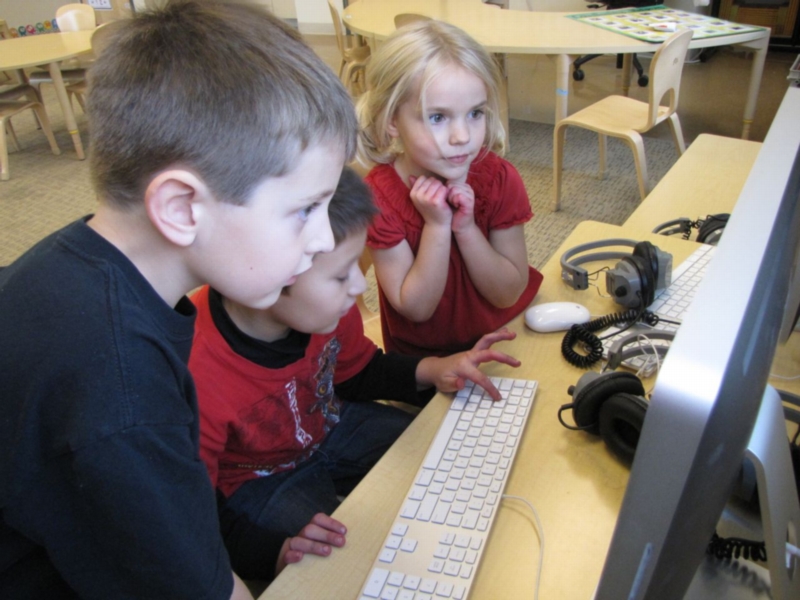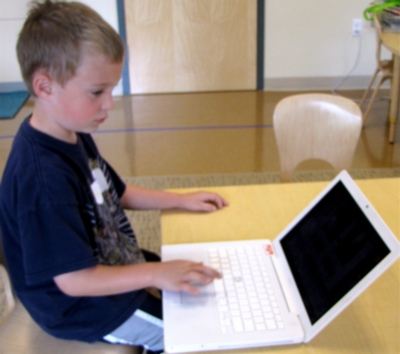|
|||||||||||||||
|
|||||||||||||||
|
Description
Desktop and laptop computers are now a rather common feature of early childhood classrooms. They can serve a number of classic functions in support of student learning. Once viewed as the information hub of the classroom, the desktop computer is rapidly becoming antiquated by more facile and mobile computing platforms such as laptops, tablets, iPod Touch, and an assortment of emergent technologies. There can still be a place in classrooms for this classic tool in part because of its larger screen, hard-wired connections and ability to perform a multitude of functions. Our preferred platform is still the iMac, however as noted below, there are a number of other form factors that are also desirable. Laptops have the advantage of mobility, and sport a standard-sized keyboard, however they have a smaller screen which can make multi-user use more challenging.
Suggestions for use
One of the first considerations when utilizing a desktop computer in a classroom is its plac  ement. It needs to be proximal to an outlet, out of major traffic flow, away from potential flying objects and liquids, and placed in such a way that neither reflected glare or backlighting from windows in the room make viewing the screen a challenge. If the computer does not have a fast wireless card, access to an ethernet outlets can also be important. Finally, we suggest that it is a best practice to set two chairs in front of each computer which facilitates 2 or more students working together. Many of the same issues apply to laptops, however they benefit from being able to be moved to be charged, or to be out of harms way. Laptops also have the advantage of being able to follow the project, including outside and temporarily away from a power source. If you will be using an interactive whiteboard in your classroom, a computer will be the critical tool for bringing this display and interface to life. ement. It needs to be proximal to an outlet, out of major traffic flow, away from potential flying objects and liquids, and placed in such a way that neither reflected glare or backlighting from windows in the room make viewing the screen a challenge. If the computer does not have a fast wireless card, access to an ethernet outlets can also be important. Finally, we suggest that it is a best practice to set two chairs in front of each computer which facilitates 2 or more students working together. Many of the same issues apply to laptops, however they benefit from being able to be moved to be charged, or to be out of harms way. Laptops also have the advantage of being able to follow the project, including outside and temporarily away from a power source. If you will be using an interactive whiteboard in your classroom, a computer will be the critical tool for bringing this display and interface to life.
A plethora of software has been written for computers as they were the original digital classroom interface. Much like any potential classroom learning tool, these software programs and hardware peripherals should be thoughtfully reviewed using evaluation criteria based on the NAEYC technology position statement as well other established criteria. Early literacy tools in the form of reading, writing, and interactive phonemic applications can provide activities for which this platform is well designed. While Science - Desktops and laptops are excellent tools for young scientists. The ability of these tools to support Web searches, to play video clips, to access interactive encyclopedias, and utilize CD ROM tools such as Sammy's Science House or "The Way Things Work" makes them facile and powerful. Furthermore, the ability of the computer to serve as the display terminal for a digital microscopes opens up that hidden world and allows it to be displayed for multiple individuals at once. As the digital hub in the classroom, the computer is the place where students download their photos into the classroom's searchable database of photographs. These can be tagged and labeled and serve as a classic ongoing documentation of the classroom's learning experiences over the course of the year. A computer is also the easiest platform for children to download and edit video that they might take. Once these videos are downloaded, the size of the screen again allows multiple viewers. This is also the case for the viewing of videos that display educational content from other sources. The NASA Website has some wonderful video clips,
A further use for classroom computers is as an interface that supports creativity. One of the most recognized and enduring early childhood applications is Kidpix. This application provides users with a set of drawing and painting tools on an easy-to-use palate. This program can allow children to create animations, import photographs, use sounds to support their creations. Somewhat older children can use computers creatively using tools such as kidspiration, comic life, or even classics like powerpoint.
We have assembled a collection of images of students and teachers using desktops and laptops and will be posting lesson plans and ideas shortly.
|
|||||||||||||||
|
|||||||||||||||




 not as portable as a tablet, computers have larger screens and their permanence makes headphone use a little more functional and this is important when listening to audio. Finally, most have a CD drive that can allow many interactive books and audiobooks to be easily enjoyed. ` While this was once the premier and only platform for interactive books, I do believe that the tablet computer is now a more powerful, portable, intimate, and functional platform for virtual books. While there are interactive literacy and phonic programs for computers, these too seem to be more
not as portable as a tablet, computers have larger screens and their permanence makes headphone use a little more functional and this is important when listening to audio. Finally, most have a CD drive that can allow many interactive books and audiobooks to be easily enjoyed. ` While this was once the premier and only platform for interactive books, I do believe that the tablet computer is now a more powerful, portable, intimate, and functional platform for virtual books. While there are interactive literacy and phonic programs for computers, these too seem to be more functional on tablet computers with its touch screen. Computers are excellent tools for use with students in the writing of the class blog. The functional keyboard and larger screen are important features that facilitate this work that is typically scaffolded heavily by teachers. The processing power of these computers allow them to run sophisticated programs such as Dragon Speak Naturally, and this speech-to-text program will be one of the new frontiers in early childhood literacy (however it is not there yet).
functional on tablet computers with its touch screen. Computers are excellent tools for use with students in the writing of the class blog. The functional keyboard and larger screen are important features that facilitate this work that is typically scaffolded heavily by teachers. The processing power of these computers allow them to run sophisticated programs such as Dragon Speak Naturally, and this speech-to-text program will be one of the new frontiers in early childhood literacy (however it is not there yet). as does
as does 

